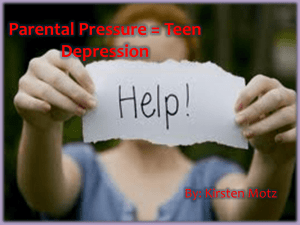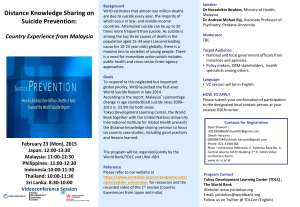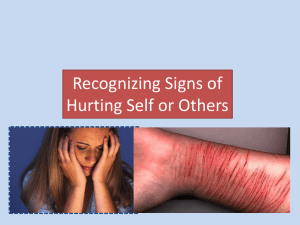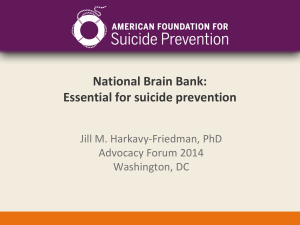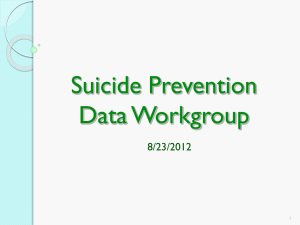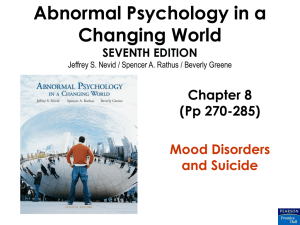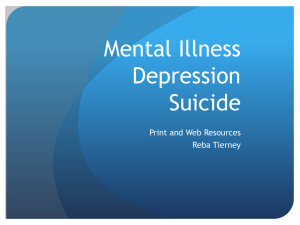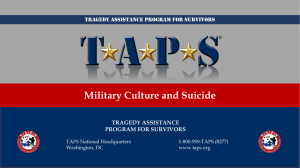Dr. Gundersen`s Power Point
advertisement
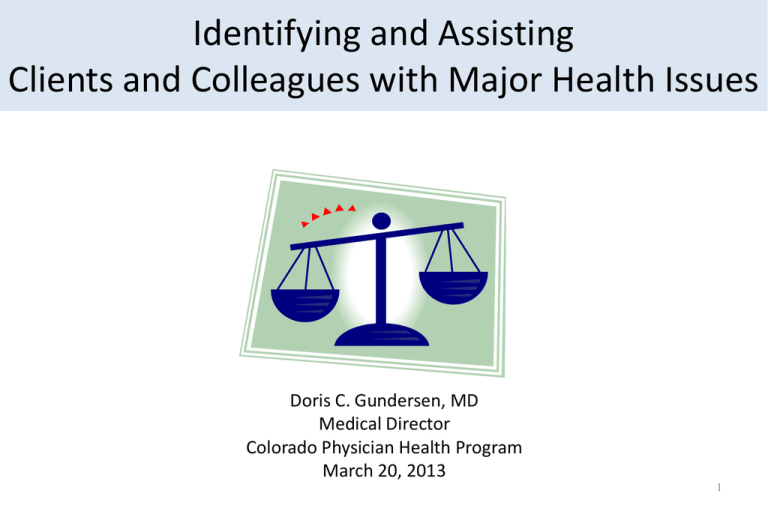
Identifying and Assisting Clients and Colleagues with Major Health Issues Doris C. Gundersen, MD Medical Director Colorado Physician Health Program March 20, 2013 1 Speaker Disclosure Statement NOTHING TO DISCLOSE 2 Objectives • Review the 8 occupational hazards professionals face which can undermine health as well as the quality of work • Identify signs and symptoms suggestive of burn out and other health problems • Recognize the warning signs and risk factors for suicide • Learn skills for successful intervention with a colleague or client • COLAP and other resources The Eight Occupational Hazards Facing Professionals – – – – – – – – High Degree of Work Stress Depression Suicide Addiction Burnout Poor Physical Health Unhealthy interpersonal relationships Professional Boundary Violations High Degree of Work Stress Attorneys and Physicians (Occupational Hazard #1) • Anticipated demands – – – – Long hours Lifelong learning Responsibility Sacrifice • Unanticipated demands – – – – – – Unhealthy workplace competition Fewer jobs available for graduates Devaluation of the Profession Diminished compensation Subordination of personal values to economic values in a work setting Reduced resources/support with increased profitability expectations of the firm (“billable hours”) – Crushing workloads and unrealistic deadlines MATRIX OF STRESS Vicariously upsetting experiences Mistakes Complaints, threats of suits/professional discipline Insufficient training in business, or necessary politics Needs of clients Needs of staff Needs of family Needs of self (often ignored until burn out sets in) MATRIX OF ATTORNEY STRESS “The work never stops.” No matter what else is going on in life, the attorney must deal with client needs, legal crises, dissatisfied clients, bad outcomes, ambiguity, complex decisions, colleagues. 25% of attorneys experience anxiety symptoms 3 or more times/month 8 The Epidemiology of Depression (Occupational Hazard #2) Depression in Primary Care Settings Depression is among the most common conditions in primary care patients (10% men and 20% women) Depression is not detected or adequately treated in 40% to 60% of cases. Physicians infrequently bring up the question of suicide with their patients, sometimes out of fear that asking about suicide will trigger suicidal behavior. Nearly 40% of those who die by suicide contact their primary care physician within the month before they die STIGMA AND SHAME STIGMA AND SHAME • • • • • • • Less friendly Withdrawn Irritable Negative/pessimistic Less available Less spontaneous Loss of humor Signs of Depression • Preoccupied • Distracted • One feels less connected to the professional (“back off” vibe) • Change in physical appearance • Physical complaints Attorneys and Depression (Occupational Hazard #2) • Attorneys are more prone to depression than any other profession (1990 Johns Hopkins University study) • Forty percent of law students meet criteria for clinical depression (Andy Benjamin Study – 1986) • The prevalence of depression among male attorneys is 19% (ABA 2013) • The prevalence of depression among male attorneys is twice that of males in the general population • Due to lack of self reporting, the rates may be higher • Due to lack of recognition or false attribution to “stress” treatment is often delayed Chief Complaint = “Stress” in 47 Consecutive Intake Evaluations Physician Population 25 20 15 10 5 0 Stress PTSD Acute Stress Other anx Dep Bip Psychot Substances None The Epidemiology of Suicide (Occupational Hazard #3) Suicide Among Attorneys (Occupational Hazard #3) • The rate of suicide among attorneys is twice that of males in the general population – (Utah State Bar J, Jan 2003) – National Institute for Safety and Health • One study suggests suicide is the 3rd leading cause of death for attorneys – (Canadian Bar Association 1997) • Ages 48-65 is the highest risk demographic Physician Suicide Rates Exceed That of Attorneys (2-4 times that of the general population) • 350 to 400 physicians in the US suicide each year • Male doctors, rates are 40% higher than for men in the general population • Female doctors, rates are 130% higher than for women in the general population • These are conservative estimates: – Death certificates do not always reveal suicide – Suicides may be attributable to “accidental” overdose/drowning/MVA Miscellaneous Facts About Suicide • 10th leading cause of death in US • 2nd leading cause of death (ages 35-44) • 3rd leading cause of death (ages 10-24) • Ratio of suicide attempts versus completed suicides 25:1 • No nationally standardized data collection among physicians or hospitals regarding attempts Methods of Suicide (US 2009) Percent Firearms Suffocation Poisoning/OD Drowning Other Cutting 19 Suicide Deaths and Major Psychiatric Syndromes 90% w/ Mental Illness Mental Illness No Mental Illness 20 Frequency of psychiatric disorder diagnoses in completed suicides 70 Percent 60 50 40 30 20 10 0 Affective D/O Personality Substance Use Anxiety D/O Schizophrenia D/O Risk Factors for Suicide • • • • • Single/divorced Chronic illness Stress/overwork Career dissatisfaction Conflicted relationships at home • Losses – personal/ professional • Conflict – personal/professional • Financial problems • Family of origin issues – Serious psychosocial problems – Abuse – Neglect • Family history – Depression and suicide – Substance abuse – Psychiatric problems Personality Traits May Contribute to Suicide Risk • Independence • Perfectionism – – – Creates a chronic feeling that nothing is good enough It is driven by an intense need to avoid failure Perfectionists are more vulnerable to depression, anxiety and other health problems • Competitiveness – It interferes with the ability to show vulnerability or seek help • Pessimism – – – – A common trait among attorneys It can help an attorney excel by being skeptical of what clients, witnesses, opposing counsel and judges say It can help anticipate the worst scenario Pessimism leads to stress and disillusionment The Lawyer Personality As children: • • • • • Highly focused on academics Great need for dominance, leadership and attention Prefer initiating activity versus following another’s lead Dominant fathers Less concern for the emotional suffering of others expressed in homes of future attorneys (compared to dentists and social workers) Susan Daicoff, “Lawyer Know Thyself”, 46 American U. L Rev. 1337 1997 Deterrents to Suicide – Dependent loved ones (including pets!) – Religious beliefs – New found hope (receiving good news) – New found resources – Changed perspective » “A DUI is bad but most (doctors/attorneys) aren’t revoked for this” – New interpretation of events » “A mistake doesn’t make me a bad (doctor/attorney/person)” 25 Addiction Among Attorneys (Occupational Hazard #4) • It is estimated that 18-20% of attorneys have a drinking problem – Alcohol Abuse – Alcohol Dependence • This is higher than what is observed in the general population and physicians (10-15%) • Liquor cabinets in law offices – time to rethink? Addiction Defined • A primary, chronic, neurobiologic disease with genetic, psychosocial, and environmental factors influencing its development and manifestations. • Characterized by one or more behaviors – Impaired control over use – Compulsive use – Continued use despite harm – Craving Law Students • Law students experience more anxiety than the general population • Psychiatric distress (OCD symptoms and paranoia) • Students frequently turn to alcohol and other drugs to cope • May establish a habit that ultimately leads to substance abuse and/or dependence in later years • Law students are universally resistant to reaching out for help • Social isolation is the norm when under stress American Association of Law Schools Study – 1994 Process Addictions and Social Media • Compulsive viewing of pornography • Gambling • Sexual addiction Workaholism is very much like substance abuse • Disrupts sleep • Creates multiple family problems & destroys marriages. • Decreases your efficiency and your ability to concentrate • Makes you irritable and fatigued. • Increases your risk of back problems, gastrointestinal disorders, heart disease and stroke. Attorney Burnout (Occupational Hazard #5) • Depersonalization – Detachment from others – Protective Defense Mechanism • Emotional exhaustion • Diminished sense of personal accomplishment – Work loses its meaning – No longer feeling a sense of efficacy The Downward Spiral Attorney/Physician Response to Stress: WORK HARDER! Loss of Avocational Neglect of Family/Friends Reduced Joy Resentment Guilt Work Harder Burnout 32 Embraces challenge and improves performance Period of maximum efficiency Hyper-reactive stage Emotional exhaustion stage Breakdown Audience Response Survey • I have a personal physician for my health care Yes? No? Poor Physical Health (Occupational Hazard #6) • Circadian Rhythm Disruption • Sustained Stress is not Benign – Sympathetic Nervous System Hyper arousal • Elevated Cortisol Levels – – – – – – Irritability Insomnia Weight Gain/Diabetes Osteoporosis Hypertension/Stroke Toxic to Neurons Neurobiology of Chronic Stress • Endorphin depletion: decreased pain tolerance • Serotonin depletion: sleep disruption and depressed mood or mood lability • Dopamine depletion: anhedonia • Locus ceruleus hyperactivity: increased noradrenalin; agitated, hypersensitivity Unhealthy Interpersonal Relationships (Occupational Hazard #7) • High divorce rates in law school • Higher divorce rates among female attorneys • “Thinking like a lawyer” doesn’t work at home • Adversarial nature of the profession: – – – – Subterfuge Conflict Distortion to persuade others disastrous in personal relationships! Professional Boundary Violations (Occupational Hazard #8) • Ubiquitous • Boundary maintenance isn’t easy • Failure to maintain boundaries threaten work and home • A lack of self care can lead to exploitation of patients or clients can can Potential boundary issues • • • • • • Sexual contact Physical contact Verbal interaction Self-disclosure Collateral contacts Fees • Appointment times and location • Dual relationships – Friend – Business transactions – Professional transactions • Workplace behavior Warning Signs of Deteriorating Health • • • • • • • • Decline in job performance Absenteeism – emotional, physical Attitude and/or mood Troubled relationships Professional boundary issues Decline in appearance Physical symptoms or illness Other • Financial problems • Staff turnover Loss of Function Hierarchy • • • • • • • Community Spiritual life Recreation and avocation Friends Peers Family Work IF WORK IS IMPACTED, PROFESSIONAL MAY BE SERIOUSLY ILL If Concerned – Trust your intuition » “I’ve noticed……” » “You seem …….” – Normalize their feelings » “Sometimes when under the stress of a lawsuit it is not that unusual for a (physician/attorney/client) to: • Feel depressed • Not Sleep • Have thoughts of “I’d rather be dead than go through this.” – Ask: Have you had thoughts like this? 43 What to Do - Always take thoughts of suicide seriously - Open a dialogue - Be direct, matter-of-factly: • • • • Are you experiencing thoughts of suicide? Do you have a plan? Be willing to listen, allow expressions of feelings Avoid being judgmental (i.e. suicide is wrong/lecturing on the value of life) Offer hope: Take Action: “There are solutions to this situation” Let them know you are going to help Do not leave the person alone if they are acutely suicidal Never Worry Alone! Contact: COLAP Colorado Lawyers Assistance Program (www.colorado.lap.org) – Barbara Ezyk, Executive Director (303) 986-3345 – Confidential assessments and referrals at no cost – Educational resources – Assistance with interventions – Health monitoring at no cost Colorado Lawyers Helping Lawyers (clhl.org) • • • • • • For less emergent situations Support Online resources Educational Resources Support groups Referral Information Colorado Physician Health Program (www.cphp.org) – Sarah Early, PsyD, Executive Director (303) 860-0122 – Confidential assessments and referrals for physicians • At no cost if licensed in Colorado – Educational resources – Assistance with interventions – Health monitoring • At no cost if licensed in Colorado – Safe Harbor from Regulatory Agency
